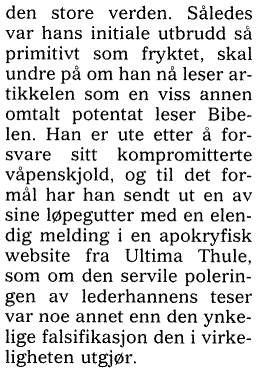2003-01-29: The debate moves on

O happy day! The great Trell has deigned to notice my miserable existence! (See the clipping on the right, if you read Norwegian. If not, I'll try to translate below.)
Three more articles have appeared in Adresseavisen since my last update:
- (2003-01-21) Magnekule magnekyler (Magnecool magnecules)
- A brief, satirical piece by physics professor Jan Myrheim, starting with a quote by Niels Bohr: I am sure they'll look so carefully that, if the particle does not exist, they won't find it either (the quote is probably not exact, as it is translated from English (or Danish?) to Norwegian and then to English).
- (2003-01-22) Matematisk tøv (Mathematical nonsense)
- By Nils Baas, explaining that the journal in which Trell published his results is unknown among the majority of mathematicians, and repeating his suggestion that he should submit his proof to a well known journal. He adds that he has received a copy of Trell's paper since last time, and he can confirm that there is not a shadow of a proof in the paper. He also refers to a very brief Norwegian version of this page, with its reference to my analysis (pdf) of Trell's paper.
- (2003-01-29) «Akterutseilte institusjoner ved NTNU» («NTNU institutions left in the dust»?) (The «quotes» are part of the title.)
-
By Erik Trell, a spirited counterattack against Nils Baas and Jan Myrheim. I have to admit a certain admiration for his vocabulary and ability to put together the most astounding sentences, though his sense of logic leaves something to be desired, in my opinion. It is with much trepidation that I venture an attempt at a translation of the part where he mentions my humble contribution. A literal translation is much too hard, but I'll do my best to preserve the spirit, if not the letter, of this magnificent oration:
(Text in [brackets] is mine.) From a man of Trell's caliber, this is high praise indeed. I notice with interest that he does consider my little note a falsification of his work, even though he calls it «pitiful». Yes, professor Trell, I know it is pitiful. Your paper simply does not contain enough substance to warrant a more clever critique from my hand. But now you'll just have to excuse me as I must go and polish my master's boots.«Thus his [Baas'] initial outburst was as primitive as feared, wonder if he now reads the paper the way a certain other potentate reads the Bible. He is trying to defend his compromised shield of armor, and for that purpose he has sent out one of his minions [yours truly] with an awful message in an apocryphal website from Ultima Thule, as if the servile polishing of the lead male's theses was anything other than the pitiful falsification it constitutes in reality.»